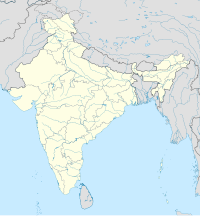| Indian Seed Vault | |
|---|---|
  | |
| General information | |
| Type | Seed bank |
| Location | Himalaya |
| Town or city | Chang La, Ladakh |
| Country | Kashmir |
| Coordinates | 34°02′49″N 77°55′50″E / 34.04704°N 77.93054°E / 34.04704; 77.93054 |
| Elevation | 17,300 feet |
| Opened | 2010 |
| Owner | Indian Government |
The Indian Seed Vault is a secure seed bank located in a high-altitude mountain pass on the Chang La in Ladakh, India. It was built in 2010 jointly by the Defence Institute of High Altitude Research and the National Bureau of Plant Genetic Resources, and is the second largest seed bank in the world.
History
| This section needs expansion. You can help by adding to it. (January 2023) |
In the late 1980s, the movement was initiated by the group of activists of Hemwal Valley of Tehri and led by a farmer and social activist Vijay Jardhari. ‘Beej Bachao Andolan’ (Save the Seeds Movement) was started from Jardhargaon of Tehri district, Uttarakhand.
Because of the adverse effects of Green revolution, many indigenous practises and seeds have been lost. There were once more than 3000 varieties of rice in Garhwal before the Green Revolution, now there are 320. “We started the ‘Beej Bachao Andolan’ as an awareness campaign in 1989 for farmers to discontinue growing cash crops like peas, potatoes and soybeans, and promote indigenous practices like the ‘Baranaja’,” Vijay Jardhari said. It is a traditional method of mixed farming and intercropping of twelve species in agriculture.
A movement to revive the old traditions of agriculture and against the agro-business policies which allegedly only benefits the rich people, this movement also promotes the traditional practises of the villagers like controlling the pests by using the leaves of walnut and neem.
Seed storage
The vault stores over 10,000 seeds and 200 plant species. These seeds include apricots, barley, cabbage, carrots, radish, potatoes, tomatoes, rice, and wheat, chosen based on qualities such as yield or resistance to temperature, pests and humidity.
See also
References
- "Freezing Future: Inside Chang La, India's Doomsday Vault In The Himalayas". The Better India. 1 March 2018.
- Dobson, Jim. "A Doomsday Vault In India Holds Frozen Storage For The Survival Of Future Generations". Forbes.
- "Seed safety vault in Ladakh". www.telegraphindia.com. Retrieved 14 December 2020.
This article about an Indian building or structure is a stub. You can help Misplaced Pages by expanding it. |
- 2010 establishments in Jammu and Kashmir
- 2010 in the environment
- Agricultural organisations based in India
- Conservation projects
- Disaster recovery
- Emergency management in India
- Gene banks
- Indian companies established in 2010
- Protected areas of India
- Science and technology in India
- Seed associations
- Tunnels in India
- Indian building and structure stubs